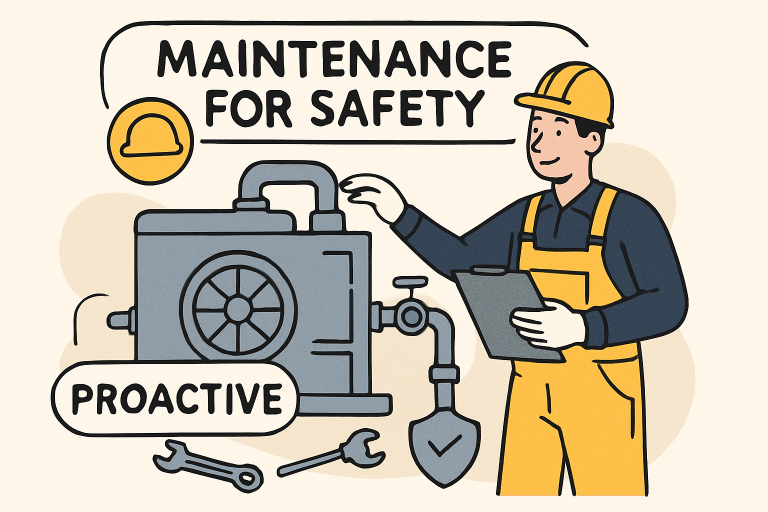How maintenance helps prevent safety issues
Key takeaways
- Regular and predictive maintenance are proactive approaches that minimize workplace hazards.
- Preventive and technology-driven maintenance strategies enhance safety and operational efficiency.
- Effective maintenance protects workers, extends equipment lifespan, and ensures regulatory compliance.
- Real-world examples underscore the necessity of robust maintenance programs across industries.
Table of contents
- Introduction
- Preventive Maintenance: A Proactive Approach
- Predictive Maintenance: Leveraging Technology for Safety
- Key Benefits of Regular Maintenance
- Implementing Effective Maintenance Strategies
- Final Thoughts
Introduction
Routine maintenance practices are fundamental in fostering a safe workplace. By systematically inspecting and servicing assets, organizations can catch potential hazards before they become serious threats. Early identification of problems, whether heavy machinery or complex HVAC systems, is critical to reducing the likelihood of workplace incidents. Timely upkeep minimizes risks and is integral to meeting regulatory requirements and protecting employees and property.
Comprehensive maintenance practices cover various systems and equipment, from industrial machinery to essential utilities like heating and cooling. In environments where climate control is vital, such as Tucson, reliable furnace installation in Tucson, AZ ensures safety and comfort. Proactive attention to these essential systems limits exposure to operational hazards and establishes a culture of prevention rather than reaction.
Preventive maintenance: A proactive approach
Preventive maintenance involves regularly scheduled inspections, repairs, and replacements. This approach identifies and addresses issues before they result in equipment failure or safety incidents. Tasks may include cleaning, lubrication, adjustment, and systematically replacing parts subject to wear and tear. By acting on potential faults in advance, organizations diminish the risk of mechanical malfunctions and workplace accidents.
For example, a manufacturing facility might schedule quarterly inspections of all conveyor belts to check for frayed edges, misalignments, or weakened motors. By catching problems early, operators can avoid unexpected downtimes, injuries, or disruptions. Preventive maintenance thus fosters a culture of safety accountability throughout the organization.
Predictive maintenance: Leveraging technology for safety
Sensor technology and data analytics have ushered in a new era of workplace safety. Predictive maintenance utilizes real-time monitoring tools—such as vibration sensors, temperature gauges, and acoustic detectors—to continuously assess the health of equipment. Software systems analyze this data to identify patterns indicating a high failure risk. Maintenance teams can then intervene before these irregularities lead to hazardous events.
This approach yields several advantages. Not only does predictive maintenance reduce the likelihood of accidents, but it also aids in scheduling interventions that minimize production disruptions. For organizations operating in high-demand environments, such as hospitals or energy plants, this added layer of foresight is crucial to safeguarding both occupants and assets. According to a report by AIChE, predictive strategies are a best practice for ensuring workplace safety standards.

Key benefits of regular maintenance
- Minimized Equipment Downtime: Proactive maintenance prevents unexpected breakdowns, which can halt workflows and increase risk exposure for all involved.
- Extended Equipment Lifespan: Regular servicing significantly lengthens the operational life of machines and systems, making them safer and more reliable.
- Enhanced Employee Safety: Employees can perform their duties confidently, knowing that equipment functions safely and as intended.
- Regulatory Compliance: Routine maintenance ensures organizations meet legal safety standards, helping them avoid costly violations.
Implementing effective maintenance strategies
Develop a Maintenance Schedule
Start by inventorying all equipment and infrastructure, then create a calendar for inspections, servicing, and testing. Prioritize critical systems to ensure essential operations always remain protected.
Utilize Maintenance Management Systems
Leveraging digital tools like Computerized Maintenance Management Systems (CMMS) improves recordkeeping and automates work order assignments. These platforms make it easier to track the status of repairs and catch patterns of recurring faults.
Train Maintenance Personnel
Ongoing education for staff is vital. Training programs should cover both foundational safety practices and emerging technologies, ensuring personnel are prepared to handle the evolving complexity of modern equipment.
Prevention is always the better remedy
An organization’s commitment to regular and predictive maintenance reflects its dedication to safety, productivity, and operational integrity.
By proactively addressing equipment and infrastructure issues, businesses can avert costly accidents, maintain regulatory compliance, and foster an environment where employees feel secure. The lessons learned from aviation to manufacturing industries illustrate maintenance’s far-reaching impact—proving that prevention is always the better remedy.




